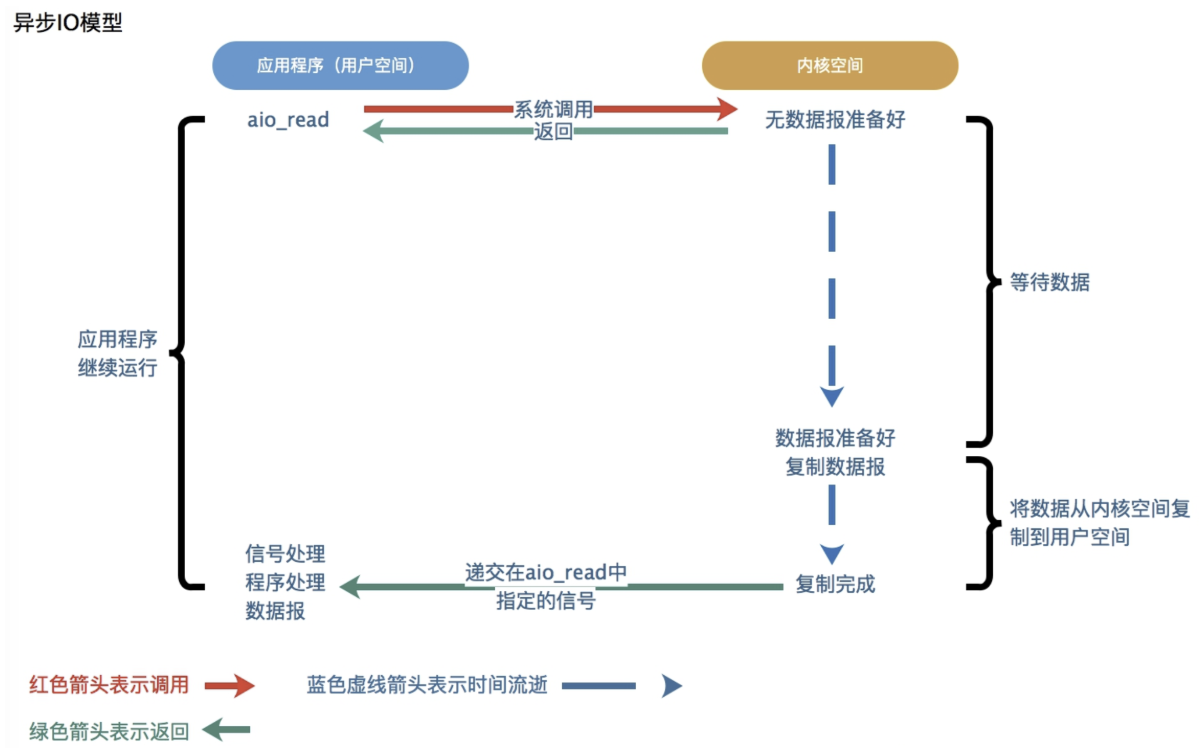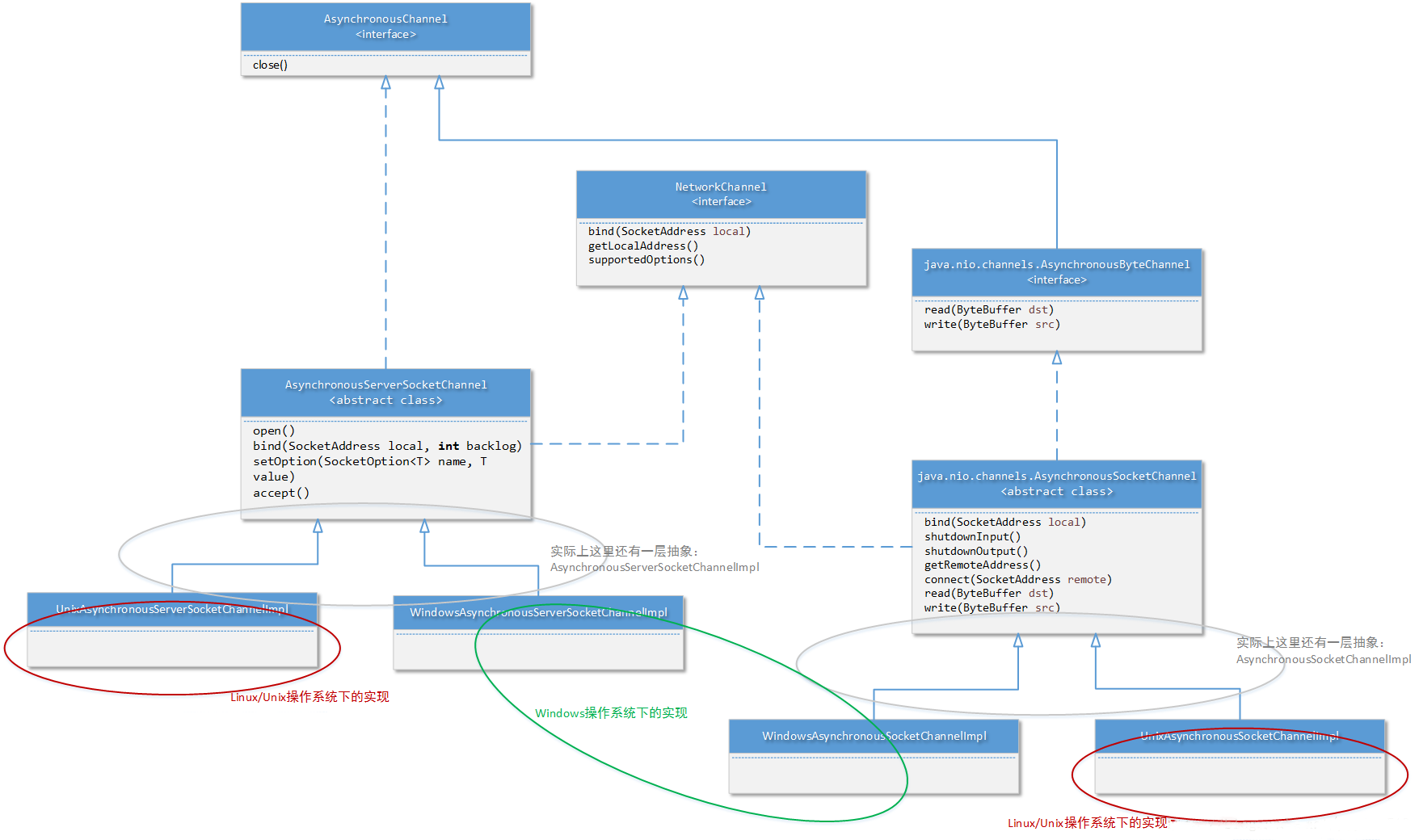IO模型之AIO代码及其实践详解
一、AIO简介
AIO是java中IO模型的一种,作为NIO的改进和增强随JDK1.7版本更新被集成在JDK的nio包中,因此AIO也被称作是NIO2.0。区别于传统的BIO(Blocking IO,同步阻塞式模型,JDK1.4之前就存在于JDK中,NIO于JDK1.4版本发布更新)的阻塞式读写,AIO提供了从建立连接到读、写的全异步操作。AIO可用于异步的文件读写和网络通信。
二、同步/异步、阻塞/非阻塞
我们先来了解下什么是同步/异步,以及什么是阻塞/非阻塞。在IO操作中,IO分两阶段(一旦拿到数据后就变成了数据操作,不再是IO):
- 数据准备阶段
- 内核空间复制数据到用户进程缓冲区(用户空间)阶段 在操作系统中,程序运行的空间分为内核空间和用户空间。 应用程序都是运行在用户空间的,所以它们能操作的数据也都在用户空间。
- 同步和异步IO的概念:同步是用户线程发起I/O请求后需要等待或者轮询内核I/O操作完成后才能继续执行 异步是用户线程发起I/O请求后仍需要继续执行,当内核I/O操作完成后会通知用户线程,或者调用用户线程注册的回调函数。
- 阻塞和非阻塞IO的概念: 阻塞是指I/O操作需要彻底完成后才能返回用户空间 非阻塞是指I/O操作被调用后立即返回一个状态值,无需等I/O操作彻底完成。
一般来讲: 阻塞IO模型、非阻塞IO模型、IO复用模型(select/poll/epoll)、信号驱动IO模型都属于同步IO,因为阶段2是阻塞的(尽管时间很短)。同步IO和异步IO的区别就在于第二个步骤是否阻塞: 如果不阻塞,而是操作系统帮你做完IO操作再将结果返回给你,那么就是异步IO。
三、异步IO模型

异步IO则采用“订阅-通知”模式:即应用程序向操作系统注册IO监听,然后继续做自己的事情。当操作系统发生IO事件,并且准备好数据后,在主动通知应用程序,触发相应的函数。也可以如下图理解:

和同步IO一样,异步IO也是由操作系统进行支持的。微软的windows系统提供了一种异步IO技术:IOCP(I/O CompletionPort,I/O完成端口);Linux下由于没有这种异步IO技术,所以使用的是epoll对异步IO进行模拟。
四、JAVA AIO框架简析

JAVA AIO框架在windows下使用windows IOCP技术,在Linux下使用epoll多路复用IO技术模拟异步IO,这个从JAVA AIO框架的部分类设计上就可以看出来。例如框架中,在Windows下负责实现套接字通道的具体类是“sun.nio.ch.WindowsAsynchronousSocketChannelImpl”,在Linux下负责实现套接字通道的具体类是“sun.nio.ch.UnixAsynchronousServerSocketChannelImpl”,如下图在Mac上安装的JDK可以看到:

另外特别说明一下,请注意在上图中的“java.nio.channels.NetworkChannel”接口,这个接口同样被JAVA NIO框架实现了,如上图所示:SocketChannel以及ServerSocketChannel就是NetworkChannel的实现。
在java中,支持异步模型的方式有两个类:
- Future类
- Callable接口
严格来说,Future不能算是异步模型的类,因为future.get()方法是阻塞的,需要等待处理完成;而Callable是回调,是正宗的异步模型工具。一般来说,异步编程都是基于回调的。
五、AIO重要类
实现一个最简单的AIO socket通信server、client,主要需要这些相关的类和接口:
AsynchronousServerSocketChannel服务端Socket通道类,负责服务端Socket的创建和监听;
AsynchronousSocketChannel客户端Socket通道类,负责客户端消息读写;
CompletionHandler<A,V>消息处理回调接口,是一个负责消费异步IO操作结果的消息处理器;
ByteBuffer负责承载通信过程中需要读、写的消息。
此外,还有可选的用于异步通道资源共享的AsynchronousChannelGroup类,接下来将一一介绍这些类的主要接口及使用。
1、AsynchronousServerSocketChannel
AsynchronousServerSocketChannel是一个流式监听套接字的异步通道,是ServerSocketChannel的异步版本的通道,支持异步处理。AsynchronousServerSocketChannel的使用和ServerSocketChannel一样需要经过三个步骤:创建/打开通道、绑定地址和端口和监听客户端连接请求。
1.1 创建/打开通道
try {
AsynchronousServerSocketChannel serverSocketChannel = AsynchronousServerSocketChannel.open();
} catch (IOException e) {
e.printStackTrace();
}
当打开通道失败时,会抛出一个IOException异常。
1.2 绑定地址和端口
通过调用AsynchronousServerSocketChannel.bind(SocketAddress)方法来绑定监听地址和端口:
// 构建一个InetSocketAddress实例以指定监听的地址和端口,如果需要指定ip,则调用InetSocketAddress(ip,port)构造方法创建即可
serverSocketChannel.bind(new InetSocketAddress(port));
1.3 监听和接收客户端连接请求
监听客户端连接请求,主要通过调用AsynchronousServerSocketChannel.accept()方法完成。accept()有两个重载方法:
public abstract <A> void accept(A,CompletionHandler<AsynchronousSocketChannel,? super A>);
public abstract Future<AsynchronousSocketChannel> accept();
这两个重载方法的行为方式完全相同一种基于Future,一种基于回调,事实上,AIO的很多异步API都封装了诸如此类的重载方法:提供CompletionHandle回调参数或者返回一个Future<T>类型变量。用过Feture接口的都知道,可以调用Feture.get()方法阻塞等待调用结果。无论是哪种方式来获取连接,最终的处理对象都是Socket,和ServerSocketChannel不同的是,这里的socket是封装在AsynchronousSocketChannel中的。
基于Future实现:
public void AsynchronousServerSocketChannel() {
try {
AsynchronousServerSocketChannel channel = AsynchronousServerSocketChannel.open();
channel.bind(new InetSocketAddress(8888));
while (true) {
Future<AsynchronousSocketChannel> conn = channel.accept();
// 阻塞等待直到future有结果
AsynchronousSocketChannel asyncSocketChannel = conn.get();
// 异步处理连接
asyncHandle(asyncSocketChannel);
}
} catch (IOException | InterruptedException | ExecutionException e) {
e.printStackTrace();
}
}
基于回调:
public void AsynchronousServerSocketChannelCallback() {
try {
AsynchronousServerSocketChannel channel = AsynchronousServerSocketChannel.open();
channel.bind(new InetSocketAddress(8888));
channel.accept(null, new CompletionHandler<AsynchronousSocketChannel, Void>() {
@Override
public void completed(AsynchronousSocketChannel result, Void attachment) {
// 接收到新的客户端连接时调用,result就是和客户端的连接对话,此时可以通过result和客户端进行通信
System.out.println("accept completed");
// 异步处理连接
asyncHandle(result);
// 继续监听accept
channel.accept(null, this);
}
@Override
public void failed(Throwable exc, Void attachment) {
// accept失败时回调
System.out.println("accept failed");
}
});
// 让主线程保持存活
while (true) {
System.in.read();
}
} catch (IOException e) {
e.printStackTrace();
}
}
需要注意的是,AsynchronousServerSocketChannel是线程安全的,但在任何时候同一时间内只能允许有一个accept操作。因此,必须得等待前一个accept操作完成之后才能启动下一个accept:
serverSocketChannel
.accept(serverSocketChannel, new CompletionHandler<AsynchronousSocketChannel,
AsynchronousServerSocketChannel>() {
@Override
public void completed(final AsynchronousSocketChannel result,
final AsynchronousServerSocketChannel attachment) {
// 接收到新的客户端连接,此时本次accept已经完成
// 继续监听下一个客户端连接到来
serverSocketChannel.accept(serverSocketChannel,this);
// result即和该客户端的连接会话
// 此时可以通过result与客户端进行交互
}
...
});
此外,还可以通过以下方法获取和设置AsynchronousServerSocketChannel的socket选项:
// 设置socket选项
serverSocketChannel.setOption(StandardSocketOptions.SO_KEEPALIVE,true);
// 获取socket选项设置
boolean keepAlive = serverSocketChannel.getOption(StandardSocketOptions.SO_KEEPALIVE);
其中StandardSocketOptions类封装了常用的socket设置选项。
获取本地地址:
InetSocketAddress address = (InetSocketAddress) serverSocketChannel.getLocalAddress();
1.4 AsynchronousChannelGroup异步通道组
try {
ExecutorService pool = Executors.newCachedThreadPool();
AsynchronousChannelGroup group = AsynchronousChannelGroup.withCachedThreadPool(pool, 10);
AsynchronousServerSocketChannel serverSocketChannel = AsynchronousServerSocketChannel.open(group);
} catch (IOException e) {
e.printStackTrace();
}
AsynchronousServerSocketChannel提供了设置通道分组(AsynchronousChannelGroup)的功能,以实现组内通道资源共享。可以调用open(AsynchronousChannelGroup)重载方法创建指定分组的通道,默认情况下,具有 open() 方法的通道属于一个全局通道组,可利用如下系统变量对其进行配置:
java.nio.channels.DefaultThreadPoolthreadFactory,其不采用默认设置,而是定义一个 java.util.concurrent.ThreadFactoryjava.nio.channels.DefaultThreadPool.initialSize,指定线程池的初始规模
java.nio.channels.AsynchronousChannelGroup 中的三个实用方法提供了创建新通道组的方法:
withCachedThreadPool()
withFixedThreadPool()
withThreadPool()
这些方法或者对线程池进行定义,如 java.util.concurrent.ExecutorService,或者是 java.util.concurrent.ThreadFactory。例如,以下调用创建了具有线程池的新的通道组,该线程池包含 10 个线程,其中每个都构造为来自 Executors 类的线程工厂:
AsynchronousChannelGroup tenThreadGroup =
AsynchronousChannelGroup.withFixedThreadPool(10, Executors.defaultThreadFactory());
三个异步网络通道都具有 open() 方法的替代版本,它们采用给出的通道组而不是默认通道组。例如,当有异步操作请求时,此调用告诉 channel 使用 tenThreadGroup 而不是默认通道组来获取线程:
AsynchronousServerSocketChannel channel = AsynchronousServerSocketChannel.open(tenThreadGroup);
定义自己的通道组可更好地控制服务于操作的线程,并能提供关闭线程或者等待终止的机制。
AsynchronousChannelGroup封装了处理由绑定到组的异步通道所触发的I/O操作完成所需的机制。每个AsynchronousChannelGroup关联了一个被用于提交处理I/O事件和分发消费在组内通道上执行的异步操作结果的completion-handlers的线程池。除了处理I/O事件,该线程池还有可能处理其他一些用于支持完成异步I/O操作的任务。从上面例子可以看到,通过指定AsynchronousChannelGroup的方式打开AsynchronousServerSocketChannel,可以定制server channel执行的线程池。如果不指定AsynchronousChannelGroup,则AsynchronousServerSocketChannel会归类到一个默认的分组中。
2、AsynchronousSocketChannel
AsynchronousSocketChannel和NIO通道是SocketChannel功能相似。是一个流式连接套接字的异步通道。
AsynchronousSocketChannel表示服务端与客户端之间的连接通道。客户端可以通过调用AsynchronousSocketChannel静态方法open()创建,而服务端则通过调用AsynchronousServerSocketChannel.accept()方法后由AIO内部在合适的时候创建。下面以客户端实现为例,介绍AsynchronousSocketChannel。
2.1 创建AsynchronousSocketChannel
需要通过open()创建和打开一个AsynchronousSocketChannel实例,再调用其connect()方法连接到服务端,接着才可以与服务端交互:
// 打开一个socket通道
AsynchronousSocketChannel socketChannel = AsynchronousSocketChannel.open();
// 阻塞等待连接成功
socketChannel.connect(new InetSocketAddress(ip,port)).get();
// 连接成功,接下来可以进行read、write操作
同AsynchronousServerSocketChannel,AsynchronousSocketChannel也提供了open(AsynchronousChannelGroup)方法用于指定通道分组和定制线程池。
2.2 connect
socketChannel.connect()也提供了CompletionHandler回调和Future返回值两个重载方法,上面例子使用带Future返回值的重载,并调用get()方法阻塞等待连接建立完成。
// 基于回调
public abstract <A> void connect(SocketAddress remote, A attachment, CompletionHandler<Void,? super A> handler);
// 基于Future 调用get()方法阻塞等待连接建立完成
public abstract Future<Void> connect(SocketAddress remote);
2.3 发送消息
可以构建一个ByteBuffer对象并调用socketChannel.write(ByteBuffer)方法异步发送消息,并通过CompletionHandler回调接收处理发送结果:
ByteBuffer writeBuf = ByteBuffer.wrap("From socketChannel:Hello i am socketChannel".getBytes());
socketChannel.write(writeBuf, null, new CompletionHandler<Integer, Object>() {
@Override
public void completed(final Integer result, final Object attachment) {
// 发送完成,result:总共写入的字节数
}
@Override
public void failed(final Throwable exc, final Object attachment) {
// 发送失败
}
});
2.4 读取消息
构建一个指定接收长度的ByteBuffer用于接收数据,调用socketChannel.read()方法读取消息并通过CompletionHandler处理读取结果:
ByteBuffer readBuffer = ByteBuffer.allocate(128);
socketChannel.read(readBuffer, null, new CompletionHandler<Integer, Object>() {
@Override
public void completed(final Integer result, final Object attachment) {
// 读取完成,result:实际读取的字节数。如果通道中没有数据可读则result=-1。
} @Override
public void failed(final Throwable exc, final Object attachment) {
// 读取失败
}
});
此外,AsynchronousSocketChannel也封装了设置/获取socket选项的方法:
// 设置socket选项
socketChannel.setOption(StandardSocketOptions.SO_KEEPALIVE,true);
// 获取socket选项设置
boolean keepAlive = socketChannel.getOption(StandardSocketOptions.SO_KEEPALIVE);
注意:读写操作,有多个重载的Future和回调式的read和write方法:
public abstract <A> void read(ByteBuffer dst,
long timeout,
TimeUnit unit,
A attachment,
CompletionHandler<Integer,? super A> handler);
public final <A> void read(ByteBuffer dst,
A attachment,
CompletionHandler<Integer,? super A> handler)
public abstract Future<Integer> read(ByteBuffer dst);
public abstract <A> void read(ByteBuffer[] dsts,
int offset,
int length,
long timeout,
TimeUnit unit,
A attachment,
CompletionHandler<Long,? super A> handler);
// write
public abstract <A> void write(ByteBuffer src,
long timeout,
TimeUnit unit,
A attachment,
CompletionHandler<Integer,? super A> handler);
public final <A> void write(ByteBuffer src,
A attachment,
CompletionHandler<Integer,? super A> handler);
public abstract Future<Integer> write(ByteBuffer src);
public abstract <A> void write(ByteBuffer[] srcs,
int offset,
int length,
long timeout,
TimeUnit unit,
A attachment,
CompletionHandler<Long,? super A> handler);
如下服务器端示例,使用的是accept返回的channel:
// 基于future 实际上是同步的读取方式
private void asyncHandle(AsynchronousSocketChannel asyncSocketChannel) {
ByteBuffer dst = ByteBuffer.allocate(1024);
// based on Future,
// 实际上是同步处理的方式,为了不将处理变成阻塞式单连接的socket形式,使用子线程来获取输入流
new Thread(() -> {
while (asyncSocketChannel.isOpen()) {
Future<Integer> readFuture = asyncSocketChannel.read(dst);
try {
// 阻塞等待读取结果
Integer readResult = readFuture.get();
if (readResult > 0) { System.out.println(new String(dst.array(), StandardCharsets.UTF_8));
dst.clear(); } else {
// doOtherthing
}
} catch (InterruptedException | ExecutionException e) {
e.printStackTrace();
}
}
}).start(); } // 基于回调
private void asyncHandle(AsynchronousSocketChannel asyncSocketChannel) {
asyncSocketChannel.read(dst, null, new CompletionHandler<Integer, Void>() { @Override
public void completed(Integer result, Void attachment) {
if (result > 0) {
System.out.println(new String(dst.array(), StandardCharsets.UTF_8));
dst.clear();
}
// 注册回调,继续读取输入
asyncSocketChannel.read(dst, null, this); } @Override
public void failed(Throwable exc, Void attachment) {
// TODO Auto-generated method stub }
});
}
3、CompletionHandler
CompletionHandler是一个用于消费异步I/O操作结果的处理器。
AIO中定义的异步通道允许指定一个CompletionHandler处理器消费一个异步操作的结果。从上文中也可以看到,AIO中大部分的异步I/O操作接口都封装了一个带CompletionHandler类型参数的重载方法,使用CompletionHandler可以很方便地处理AIO中的异步I/O操作结果。CompletionHandler是一个具有两个泛型类型参数的接口,声明了两个接口方法:
public interface CompletionHandler<V,A> {
void completed(V result, A attachment);
void failed(Throwable exc, A attachment);
}
其中,泛型V表示I/O操作的结果类型,通过该类型参数消费I/O操作的结果;泛型A为附加到I/O操作中的对象类型,可以通过该类型参数将需要的变量传入到CompletionHandler实现中使用。因此,AIO中大部分的异步I/O操作都有一个类似这样的重载方法:
<V,A> void ioOperate(params,A attachment,CompletionHandler<V,A> handler);
例如,AsynchronousServerSocketChannel.accept()方法:
public abstract <A> void accept(A attachment,CompletionHandler<AsynchronousSocketChannel,? super A> handler);
AsynchronousSocketChannel.write()方法等:
public final <A> void write(ByteBuffer src,A attachment,CompletionHandler<Integer,? super A> handler)
当I/O操作成功完成时,会回调到completed方法,failed方法则在I/O操作失败时被回调。需要注意的是:在CompletionHandler的实现中应当即使处理操作结果,以避免一直占用调用线程而不能分发其他的CompletionHandler处理器。
六、AIO代码实现
1、服务端
public class Server {
private static int DEFAULT_PORT = 8888;
private static AsyncServerHandler serverHandle;
public volatile static long clientCount = 0;
public static void start(){
start(DEFAULT_PORT);
}
public static synchronized void start(int port){
if(serverHandle!=null)
return;
serverHandle = new AsyncServerHandler(port);
new Thread(serverHandle,"Server").start();
}
public static void main(String[] args){
Server.start();
}
}
public class AsyncServerHandler implements Runnable {
public CountDownLatch latch;
public AsynchronousServerSocketChannel channel;
public AsyncServerHandler(int port) {
try {
//创建服务端通道
channel = AsynchronousServerSocketChannel.open();
//绑定端口
channel.bind(new InetSocketAddress(port));
System.out.println("服务器已启动,端口号:" + port);
} catch (IOException e) {
e.printStackTrace();
}
}
@Override
public void run() {
//CountDownLatch初始化
//它的作用:在完成一组正在执行的操作之前,允许当前的现场一直阻塞
//此处,让现场在此阻塞,防止服务端执行完成后退出
//也可以使用while(true)+sleep
//生成环境就不需要担心这个问题,以为服务端是不会退出的
latch = new CountDownLatch(1);
//用于接收客户端的连接
channel.accept(this,new AcceptHandler());
try {
latch.await();
} catch (InterruptedException e) {
e.printStackTrace();
}
}
}
//作为handler接收客户端连接
public class AcceptHandler implements CompletionHandler<AsynchronousSocketChannel, AsyncServerHandler> {
@Override
public void completed(AsynchronousSocketChannel channel,AsyncServerHandler serverHandler) {
//继续接受其他客户端的请求
Server.clientCount++;
System.out.println("连接的客户端数:" + Server.clientCount);
serverHandler.channel.accept(serverHandler, this);
//创建新的Buffer
ByteBuffer buffer = ByteBuffer.allocate(1024);
//异步读 第三个参数为接收消息回调的业务Handler
channel.read(buffer, buffer, new ReadHandler(channel));
}
@Override
public void failed(Throwable exc, AsyncServerHandler serverHandler) {
exc.printStackTrace();
serverHandler.latch.countDown();
}
}
public class ReadHandler implements CompletionHandler<Integer, ByteBuffer> {
//用于读取半包消息和发送应答
private AsynchronousSocketChannel channel;
public ReadHandler(AsynchronousSocketChannel channel) {
this.channel = channel;
}
//读取到消息后的处理
@Override
public void completed(Integer result, ByteBuffer attachment) {
//flip操作
attachment.flip();
//根据
byte[] message = new byte[attachment.remaining()];
attachment.get(message);
try {
String expression = new String(message, "UTF-8");
System.out.println("服务器收到消息: " + expression);
String calrResult = null;
try{
calrResult = Caculator.cal(expression).toString();
}catch(Exception e){
calrResult = "计算错误:" + e.getMessage();
}
//向客户端发送消息
doWrite(calrResult);
} catch (UnsupportedEncodingException e) {
e.printStackTrace();
}
}
//发送消息
private void doWrite(String result) {
byte[] bytes = result.getBytes();
ByteBuffer writeBuffer = ByteBuffer.allocate(bytes.length);
writeBuffer.put(bytes);
writeBuffer.flip();
//异步写数据 参数与前面的read一样
channel.write(writeBuffer, writeBuffer,new CompletionHandler<Integer, ByteBuffer>() {
@Override
public void completed(Integer result, ByteBuffer buffer) {
//如果没有发送完,就继续发送直到完成
if (buffer.hasRemaining())
channel.write(buffer, buffer, this);
else{
//创建新的Buffer
ByteBuffer readBuffer = ByteBuffer.allocate(1024);
//异步读 第三个参数为接收消息回调的业务Handler
channel.read(readBuffer, readBuffer, new ReadHandler(channel));
}
}
@Override
public void failed(Throwable exc, ByteBuffer attachment) {
try {
channel.close();
} catch (IOException e) {
}
}
});
}
@Override
public void failed(Throwable exc, ByteBuffer attachment) {
try {
this.channel.close();
} catch (IOException e) {
e.printStackTrace();
}
}
}
2、客户端
public class Client {
private static String DEFAULT_HOST = "localhost";
private static int DEFAULT_PORT = 8888;
private static AsyncClientHandler clientHandle;
public static void start(){
start(DEFAULT_HOST,DEFAULT_PORT);
}
public static synchronized void start(String ip,int port){
if(clientHandle!=null)
return;
clientHandle = new AsyncClientHandler(ip,port);
new Thread(clientHandle,"Client").start();
}
//向服务器发送消息
public static boolean sendMsg(String msg) throws Exception{
if(msg.equals("q")) return false;
clientHandle.sendMsg(msg);
return true;
}
@SuppressWarnings("resource")
public static void main(String[] args) throws Exception{
Client.start();
System.out.println("请输入请求消息:");
Scanner scanner = new Scanner(System.in);
while(Client.sendMsg(scanner.nextLine()));
}
}
public class AsyncClientHandler implements CompletionHandler<Void, AsyncClientHandler>, Runnable {
private AsynchronousSocketChannel clientChannel;
private String host;
private int port;
private CountDownLatch latch;
public AsyncClientHandler(String host, int port) {
this.host = host;
this.port = port;
try {
//创建异步的客户端通道
clientChannel = AsynchronousSocketChannel.open();
} catch (IOException e) {
e.printStackTrace();
}
}
@Override
public void run() {
//创建CountDownLatch等待
latch = new CountDownLatch(1);
//发起异步连接操作,回调参数就是这个类本身,如果连接成功会回调completed方法
clientChannel.connect(new InetSocketAddress(host, port), this, this);
try {
latch.await();
} catch (InterruptedException e1) {
e1.printStackTrace();
}
try {
clientChannel.close();
} catch (IOException e) {
e.printStackTrace();
}
}
//连接服务器成功
//意味着TCP三次握手完成
@Override
public void completed(Void result, AsyncClientHandler attachment) {
System.out.println("客户端成功连接到服务器...");
}
//连接服务器失败
@Override
public void failed(Throwable exc, AsyncClientHandler attachment) {
System.err.println("连接服务器失败...");
exc.printStackTrace();
try {
clientChannel.close();
latch.countDown();
} catch (IOException e) {
e.printStackTrace();
}
}
//向服务器发送消息
public void sendMsg(String msg){
byte[] req = msg.getBytes();
ByteBuffer writeBuffer = ByteBuffer.allocate(req.length);
writeBuffer.put(req);
writeBuffer.flip();
//异步写
clientChannel.write(writeBuffer, writeBuffer,new WriteHandler(clientChannel, latch));
}
}
public class WriteHandler implements CompletionHandler<Integer, ByteBuffer> {
private AsynchronousSocketChannel clientChannel;
private CountDownLatch latch;
public WriteHandler(AsynchronousSocketChannel clientChannel, CountDownLatch latch) {
this.clientChannel = clientChannel;
this.latch = latch;
}
@Override
public void completed(Integer result, ByteBuffer buffer) {
//完成全部数据的写入
if (buffer.hasRemaining()) {
clientChannel.write(buffer, buffer, this);
} else {
//读取数据
ByteBuffer readBuffer = ByteBuffer.allocate(1024);
clientChannel.read(readBuffer, readBuffer, new ReadHandler(clientChannel, latch));
}
}
@Override
public void failed(Throwable exc, ByteBuffer attachment) {
System.err.println("数据发送失败...");
try {
clientChannel.close();
latch.countDown();
} catch (IOException e) {
}
}
}
public class ReadHandler implements CompletionHandler<Integer, ByteBuffer> {
private AsynchronousSocketChannel clientChannel;
private CountDownLatch latch;
public ReadHandler(AsynchronousSocketChannel clientChannel,CountDownLatch latch) {
this.clientChannel = clientChannel;
this.latch = latch;
}
@Override
public void completed(Integer result,ByteBuffer buffer) {
buffer.flip();
byte[] bytes = new byte[buffer.remaining()];
buffer.get(bytes);
String body;
try {
body = new String(bytes,"UTF-8");
System.out.println("客户端收到结果:"+ body);
} catch (UnsupportedEncodingException e) {
e.printStackTrace();
}
}
@Override
public void failed(Throwable exc,ByteBuffer attachment) {
System.err.println("数据读取失败...");
try {
clientChannel.close();
latch.countDown();
} catch (IOException e) {
}
}
}
3、测试类
public class Test {
//测试主方法
@SuppressWarnings("resource")
public static void main(String[] args) throws Exception {
//运行服务器
Server.start();
//避免客户端先于服务器启动前执行代码
Thread.sleep(100);
//运行客户端
Client.start();
System.out.println("请输入请求消息:");
Scanner scanner = new Scanner(System.in);
while (Client.sendMsg(scanner.nextLine())) ;
}
}
public final class Caculator {
private final static ScriptEngine jse = new ScriptEngineManager().getEngineByName("JavaScript");
public static Object cal(String expression) throws ScriptException {
return jse.eval(expression);
}
}
IO模型之AIO代码及其实践详解的更多相关文章
- IO模型之NIO代码及其实践详解
一.简介 NIO我们一般认为是New I/O(也是官方的叫法),因为它是相对于老的I/O类库新增的( JDK 1.4中的java.nio.*包中引入新的Java I/O库).但现在都称之为Non-bl ...
- php调用C代码的方法详解和zend_parse_parameters函数详解
php调用C代码的方法详解 在php程序中需要用到C代码,应该是下面两种情况: 1 已有C代码,在php程序中想直接用 2 由于php的性能问题,需要用C来实现部分功能 针对第一种情况,最合适的方 ...
- Requests实践详解
Requests是什么 Requests是用python语言基于urllib编写的,采用的是Apache2 Licensed开源协议的HTTP库 如果你看过上篇文章关于urllib库的使用,你会发现, ...
- Understand:高效代码静态分析神器详解(转)
之前用Windows系统,一直用source insight查看代码非常方便,但是年前换到mac下面,虽说很多东西都方便了,但是却没有了静态代码分析工具,很幸运,前段时间找到一款比source ins ...
- 单元测试系列之四:Sonar平台中项目主要指标以及代码坏味道详解
更多原创测试技术文章同步更新到微信公众号 :三国测,敬请扫码关注个人的微信号,感谢! 原文链接:http://www.cnblogs.com/zishi/p/6766994.html 众所周知Sona ...
- Understand:高效代码静态分析神器详解(一)
Understand:高效代码静态分析神器详解(一) Understand 之前用Windows系统,一直用source insight查看代码非常方便,但是年前换到mac下面,虽说很多东西都方便 ...
- 数据挖掘模型中的IV和WOE详解
IV: 某个特征中 某个小分组的 响应比例与未响应比例之差 乘以 响应比例与未响应比例的比值取对数 数据挖掘模型中的IV和WOE详解 http://blog.csdn.net/kevin7658/ar ...
- “全栈2019”Java异常第六章:finally代码块作用域详解
难度 初级 学习时间 10分钟 适合人群 零基础 开发语言 Java 开发环境 JDK v11 IntelliJ IDEA v2018.3 文章原文链接 "全栈2019"Java异 ...
- “全栈2019”Java异常第四章:catch代码块作用域详解
难度 初级 学习时间 10分钟 适合人群 零基础 开发语言 Java 开发环境 JDK v11 IntelliJ IDEA v2018.3 文章原文链接 "全栈2019"Java异 ...
随机推荐
- zookeeper使用过程的错误
一.zookeeper启动成功,dubbo服务也注册成功,但是服务消费者调用失败 报错如下: [myid:] - INFO [SyncThread:0:ZooKeeperServer@645] - E ...
- js Date.parse()时区问题
比较两个时间,parse() 方法可解析一个日期时间字符串,并返回 1970/1/1 午夜距离该日期时间的毫秒数.Date.parse时间多了8小时. 正确的方法: var nowDate = Dat ...
- pickle.load EOFError: Ran out of input
错误原因:pickle.loads()的次数超过了pickle.dumps()的次数 https://www.cnblogs.com/cmnz/p/6986667.html
- 【GStreamer开发】GStreamer播放教程09——数字音频传输
目标 本教程展示GStreamer是如何进行数字音频传输的. 介绍 在常见的模拟格式外,高端的音频系统通常都接受数字格式,压缩的非压缩的都能接受.因为音频信号是从电脑传到音箱,用一种更有弹性的形态会更 ...
- solr关于日期范围查询
问题:从solr上查询创建日期在2019-06-25到2019-06-26之间的数据 createDate:[2019-06-25 TO 2019-06-26]
- a标签添加移除事件及开启禁用事件
一.添加移除点击事件 <script type="text/javascript" src="jquery.min.js"></script& ...
- (模板)hdoj1251(字典树模板题)
题目链接:https://vjudge.net/problem/HDU-1251 题意:给定一系列字符串之后,再给定一系列前缀,对每个前缀查询以该字符串为前缀的字符串个数. 思路: 今天开始学字典树, ...
- 027 Android 可扩展的listview:ExpandableListView的使用案例
1.ExpandableListView简介 ExpandableListView是一种用于垂直滚动展示两级列表的视图,和 ListView 的不同之处就是它可以展示两级列表,分组可以单独展开显示子选 ...
- spring boot配置文件application.properties配置JPA以及数据源
1.application.properties配置jpa模板 spring.datasource.url=jdbc:mysql://localhost:3306/springboottest?use ...
- 【Webservice】2 counts of IllegalAnnotationExceptions Two classes have the same XML type name
在使用客户端调用服务端的时候发生了2 counts of IllegalAnnotationExceptions Two classes have the same XML type name的错误, ...
